OLDSMOBILE SILHOUETTE 1993 Owners Manual
Manufacturer: OLDSMOBILE, Model Year: 1993, Model line: SILHOUETTE, Model: OLDSMOBILE SILHOUETTE 1993Pages: 323, PDF Size: 17.13 MB
Page 251 of 323
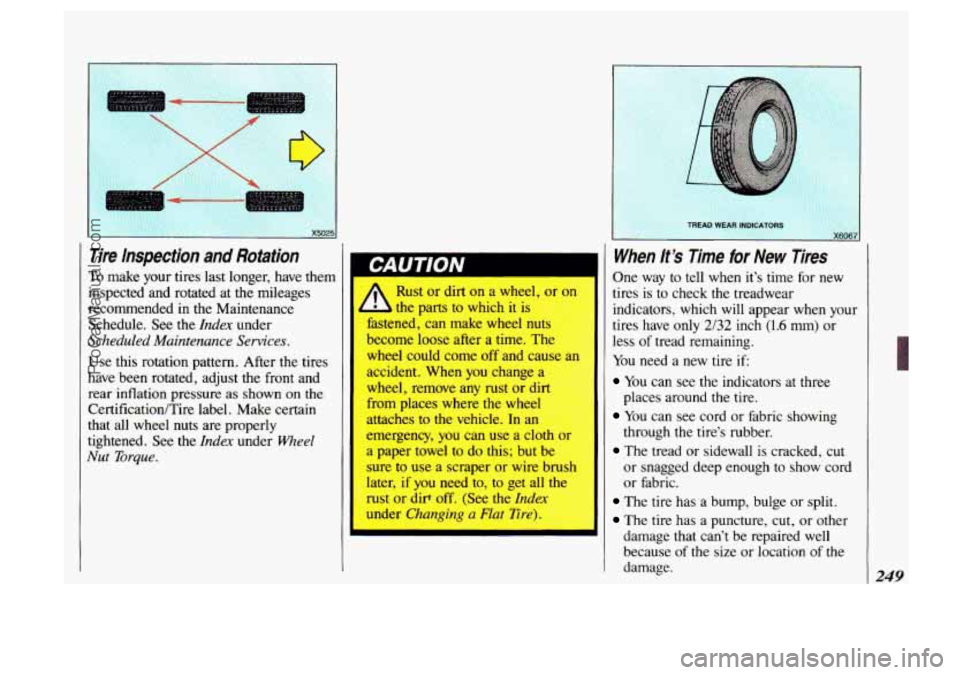
Tire lnspection and Rotation
ro make your tires last longer, have them
[nspected and rotated at the mileages
recommended in the Maintenance
Schedule. See the
Index under
Ycheduled Maintenance Services.
Use this rotation pattern. After the tires
nave been rotated, adjust the front and
rear inflation pressure
as shown on the
Zertification/Tire label. Make certain
:hat all wheel nuts are properly
ightened. See the
Index under Wheel
Vut Torque.
1
b the parts to which it i
astened, can make wheel
3ecome loose after a time.
wheel could come off and cause an
dccident. When you change a
wheel, remove any
rust or dirl
from places where the wheel
ttaches
to the vehicle. In ar
ergency, you can use a clot1
L paper towel to do this; but b
sure
to use a scraper or wire 1:
later, if you need to, to get all the '
rust or die off. (See the Idex
under Changing a Flat Tire).
When lt's Time for New Tires
One way to tell when it's time for new
tires is to check the treadwear
indicators, which will appear when your
tires have only
2/32 inch (1.6 mm) or
less
of tread remaining.
You need a new tire if:
You can see the indicators at three
You can see cord or fabric showing
The tread or sidewall is cracked, cut
places
around the tire,
through the tire's rubber.
or snagged deep enough to show cord
or fabric.
The tire has a bump, bulge or split.
The tire has a puncture, cut, or other
damage that can't be repaired well
because of the size or location of the
damage.
ProCarManuals.com
Page 252 of 323
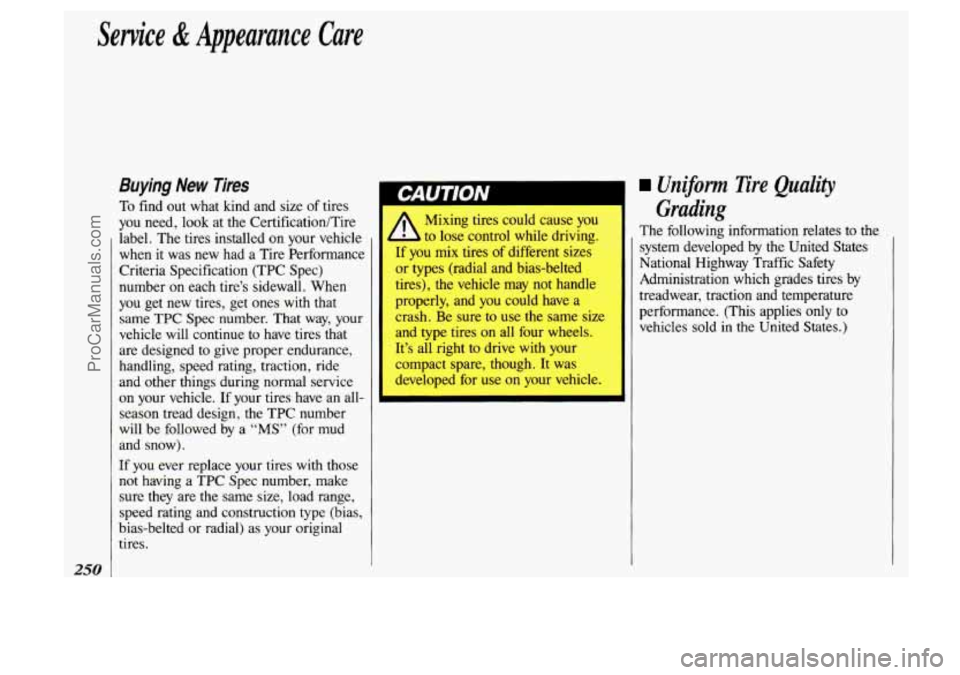
Sewice & Appearance Care
250
Buying New Tires
To find out what kind and size of tires
you need, look at the Certification/Tire
label. The tires installed on your vehicle
when it was new had a Tire Performance
Criteria Specification (TPC Spec)
number
on each tire’s sidewall. When
you get new tires, get ones with that
same
TPC Spec number. That way, your
vehicle will continue to have tires that
are designed to give proper endurance,
handling, speed rating, traction, ride
and other things during normal service
on your vehicle.
If your tires have an all-
season tread design, the TPC number
will be followed by a
“MS” (for mud
and snow).
If
you ever replace your tires with those
not having a
TPC Spec number, make
sure they are the same size, load range,
speed rating and construction type (bias,
bias-belted or radial)
as your original
tires. Mixing tires could
cause
you
to lose control while driving.
If you mix tires of different sizes
or types (radial and bias-belted
tires), the vehicle may not handle
properly, and you could have a
crash. Be sure to use the same size
and type tires on all four wheels.
It’s all right
to drive with your
compact spare, though.
It was
developed for use on your vehicle.
Uniform Tire Quality
Grading
The following information relates to the
system developed by the United States
National Highway Traffic Safety
Administration which grades tires by
treadwear, traction and temperature
performance. (This applies only to
vehicles sold
in the United States.)
u
ProCarManuals.com
Page 253 of 323
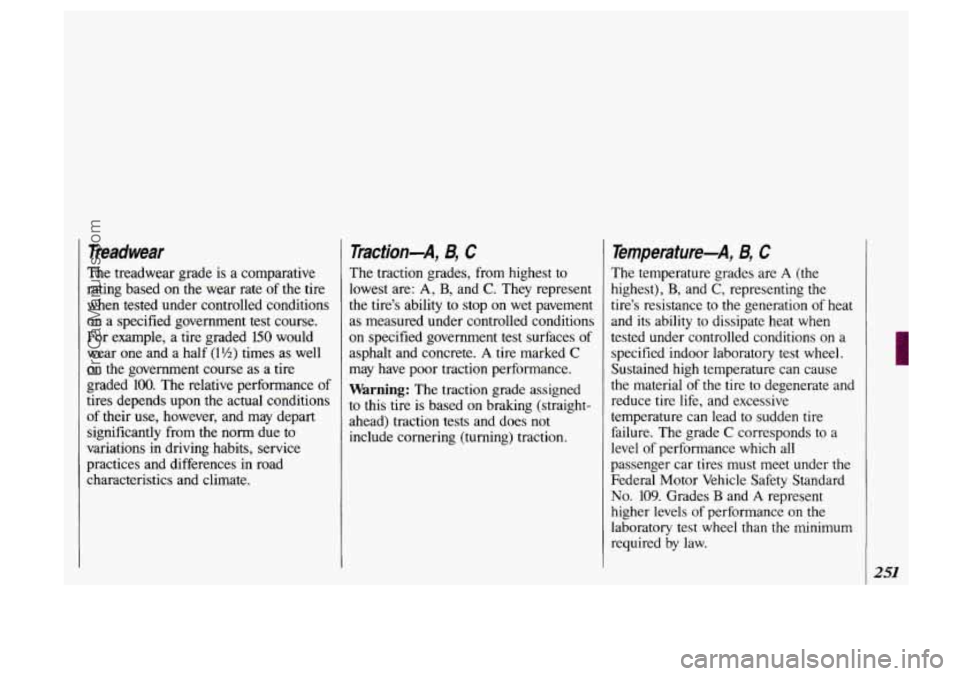
Treadwear
The treadwear grade is a comparative
rating based on the wear rate of the tire
when tested under controlled conditions
on a specified government test course.
For example, a tire graded
150 would
wear one and a half
(1%) times as well
on the government course as a tire
graded
100. The relative performance of
tires depends upon the actual conditions
of their use, however, and may depart
significantly from the norm due to
variations in driving habits, service
practices and differences in road
characteristics and climate.
Traction-A, B, C
The traction grades, from highest to
lowest are:
A, B, and C. They represent
the tire’s ability to stop on wet pavement
as measured under controlled conditions
on specified government test surfaces of
asphalt and concrete.
A tire marked C
may have poor traction performance.
Warning: The traction grade assigned
to this tire
is based on braking (straight-
ahead) traction tests and does not
include cornering (turning) traction.
Temperature-A, B, C
The temperature grades are A (the
highest),
B, and C, representing the
tire’s resistance to the generation of heat
and its ability to dissipate heat when
tested under controlled conditions
on a
specified indoor laboratory test wheel.
Sustained high temperature can cause
the material
of the tire to degenerate and
reduce tire life, and excessive
temperature can lead to sudden tire
failure. The grade
C corresponds to a
level
of performance which all
passenger car tires must meet under the
Federal Motor Vehicle Safety Standard
No. 109. Grades B and A represent
higher levels
of performance on the
laboratory test wheel than the minimum
required by law.
251
ProCarManuals.com
Page 254 of 323
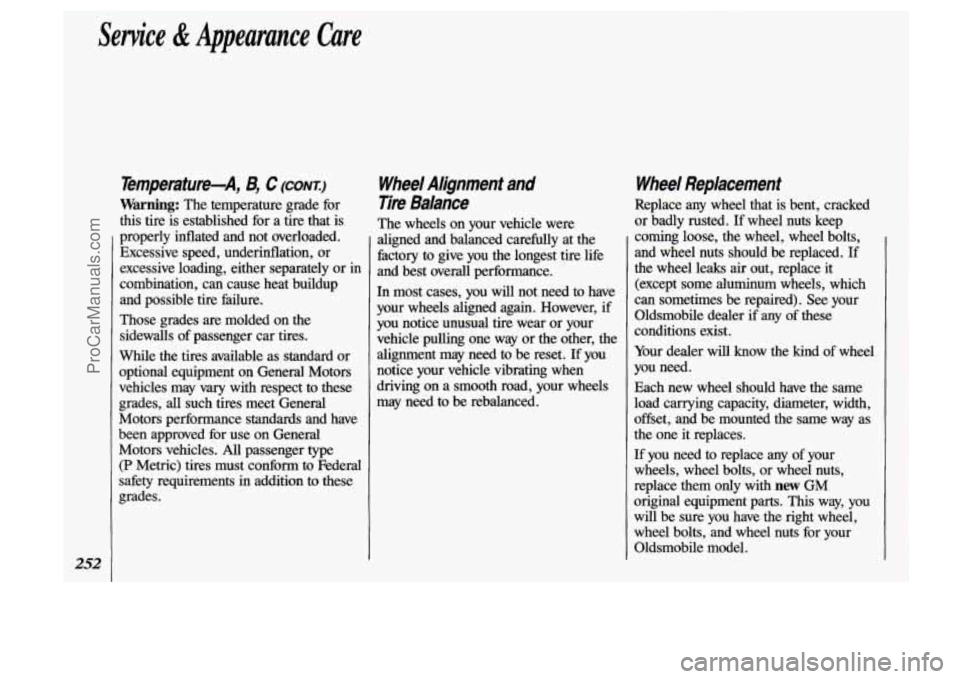
Service & Appearance Care
252
Temperature-A, B, C (CONT)
Warning: The temperature grade for
this tire is established for a tire that is
properly inflated and not overloaded. Excessive speed, underinflation, or
excessive loading, either separately or in
combination, can cause heat buildup
and possible tire failure.
Those grades are molded on the
sidewalls of passenger car tires.
While the tires available as standard or
optional equipment on General Motors
vehicles may vary with respect to these
grades, all such tires meet General
Motors performance standards and have
been approved for use on General Motors vehicles.
All passenger type
(P Metric) tires must conform to Federal
safety requirements in addition to these
grades.
Wheel Alignment and
Tire Balance
The wheels on your vehicle were
aligned and balanced carefully at the
factory to give you the longest tire life
and best overall performance.
In most cases, you will not need to have
your wheels aligned again. However,
if
you notice unusual tire wear or your
vehicle pulling one way or the other, the
alignment may need to be reset. If you
notice your vehicle vibrating when
driving on a smooth road, your wheels
may need to be rebalanced.
Wheel Replacement
Replace any wheel that is bent, cracked
or badly rusted. If wheel nuts keep
coming loose, the wheel, wheel bolts,
and wheel nuts should be replaced. If
the wheel leaks air out, replace it
(except some aluminum wheels, which
can sometimes be repaired). See your
Oldsmobile dealer
if any of these
conditions exist.
Your dealer will know the kind of wheel
you need.
Each new wheel should have the same
load carrying capacity, diameter, width,
offset, and be mounted the same way as
the one it replaces.
If you need
to replace any of your
wheels, wheel bolts, or wheel nuts,
replace them only with
new GM
original equipment parts.
This way, you
will be sure you have the right wheel,
wheel bolts, and wheel nuts for your Oldsmobile model.
ProCarManuals.com
Page 255 of 323
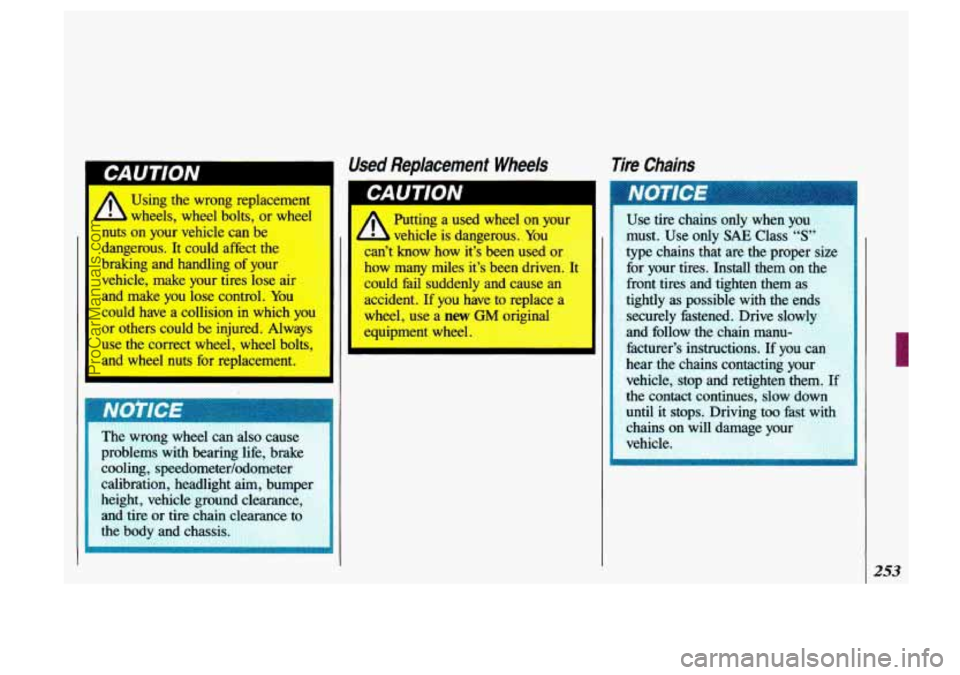
Used Replacement Wheels Tire Chains
Using the wrong replacement
b wheels, wheel bolts, or wheel
nuts on your vehicle can be
dangerous. It could affect the
braking and handling
of your
vehicle, make your tires lose air
and make you lose control. You
could have a collision in which you
)r others could be injured. Always
lse the correct wheel, wheel bolts,
1 and wheel nuts for replacement.
IL
The wrong wheel can also cause
problems with bearing life, brake cooling, speedometer/odometer
calibration, headlight aim, bumper
height,
vehicle ground clearance,
adtire
or tire chain clearance to
.the-body
.~ and chassis,;f,;,ir, ~ ~~~ .. .~. ..~ = ~ ~=.=.=~~~~ ... ~~
Putting a used wheel on your
vehicle is dangerous. You
can t
know how it’s been used or
how many miles it’s been driven. It
-ould fail suddenly and cause an
,ccident. If
you have to replace a
wheel, use
a new GM original
equipment wheel.
e
Use tire chains only when y
must. Use only SAE Class ‘23’’
type chains that are the proper size
for your tires. Install them on the
front tires and tighten them as
tightly as possible with the ends
securely fastened. Drive slowly
and follow the chain manu-
facturer’s instructions. If
you can
hear the chains contacting your
vehicle, stop and retighten them.
If
the contact continues, slow down
until it stops. Driving too fast with chains on will damage your
vehicle.
:l I ’
I
. .. ..
253
ProCarManuals.com
Page 256 of 323
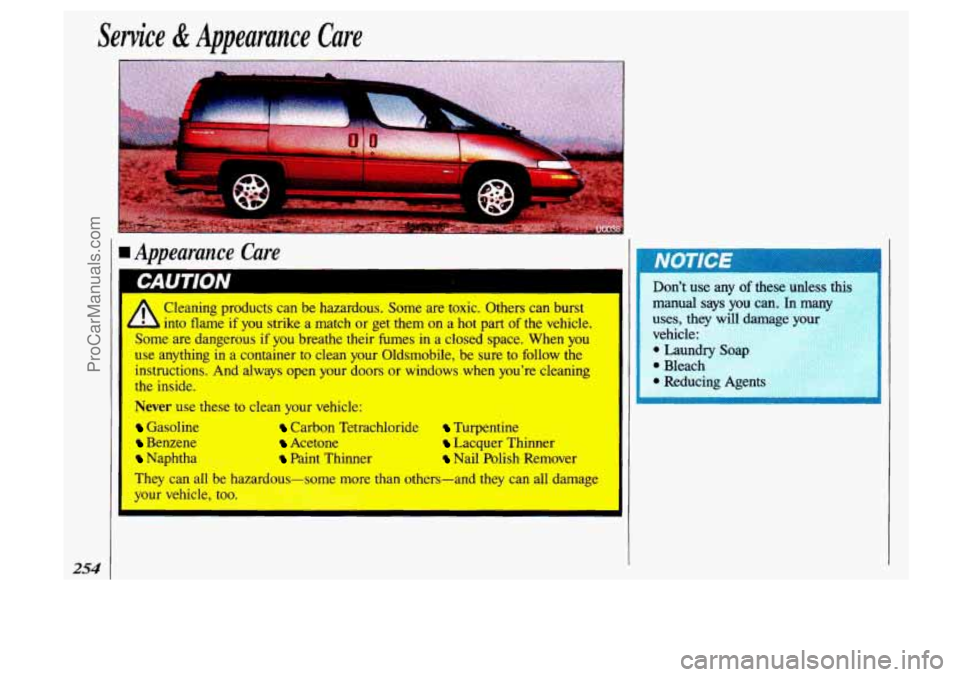
Service & Appearance Care
rn Avvearance Care
254
L
Cleaning products can be hazardous. Some are toxic. Others can burst
into flame
if you strike a match or get them on a hot part of the vehicle.
Some are dangerohs if you breathe theirfumes in a closed space. When
you
use anything in a container to clean your Oldsmobile, be sure to follow the
instructions. And always open your doors or windows when you're cleaning
the inside.
Never use these to clean your vehicle:
Gasoline Carbon Tetrachloride Turpentine
Benzene Acetone Lacquer Thinner
Naphtha Paint Thinner Nail Polish Remover
They can all be hazardous-some more than others-and they can all damage
'our vehicle, to1
I
ProCarManuals.com
Page 257 of 323
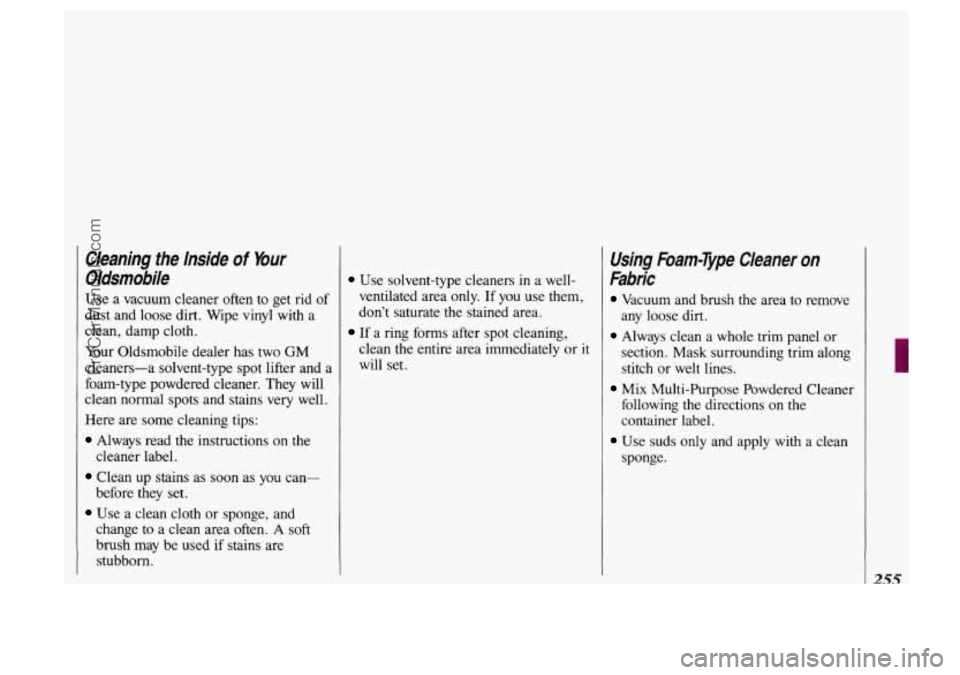
Cleaning the Inside of Your
Oldsmobile
Use a vacuum cleaner often to get rid of
dust and loose dirt. Wipe vinyl with a
clean, damp cloth.
Your Oldsmobile dealer has two GM
cleaners-a solvent-type spot lifter and a
foam-type powdered cleaner. They will
clean normal spots and stains very well.
Here are some cleaning tips:
Always read the instructions on the
cleaner label.
Clean up stains as soon as you can-
before they set.
Use a clean cloth or sponge, and
change to a clean area often.
A soft
brush may be used if stains are
stubborn.
Use solvent-type cleaners in a well-
ventilated area only. If you use them,
don’t saturate the stained area.
clean the entire area immediately or
it
will set.
If a ring forms after spot cleaning,
Using Foam-Type Cleaner on
Fabric
Vacuum and brush the area to remove
Always clean a whole trim panel or
any
loose dirt.
section. Mask surrounding trim along
stitch or welt lines.
Mix Multi-Purpose Powdered Cleaner
following
the directions on the
container label.
Use suds only and apply with a clean
sponge.
255
ProCarManuals.com
Page 258 of 323
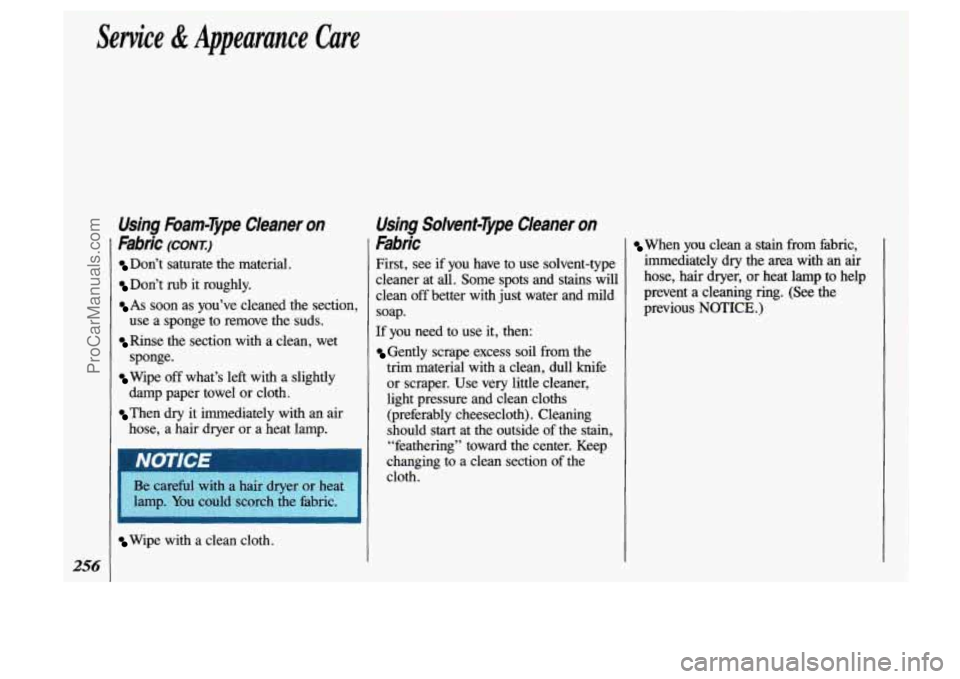
Service & Appearance Care
Using Barn-Type Cleaner on
Fabric (CONT.)
Don’t saturate the material.
Don’t rub it roughly.
As soon as you’ve cleaned the section,
use a sponge to remove the suds.
Rinse the section with a clean, wet
sponge.
Wipe off what’s left with a slightly
damp paper towel or cloth.
Then dry it immediately with an air
hose, a hair dryer or a heat lamp.
Wipe with a clean cloth.
Using Solvenf-Type Cleaner on
Fabric
First, see if you have to use solvent-type
cleaner at all. Some
spots and stains will
clean
off better with just water and mild
soap.
If you need to use it, then:
Gently scrape excess soil from the
trim material with a clean, dull knife
or scraper. Use very little cleaner,
light pressure and clean cloths (preferably cheesecloth). Cleaning should
start at the outside of the stain,
“feathering” toward the center. Keep
changing to a clean section
of the
cloth.
When you clean a stain from fabric,
immediately dry the area with
an air
hose, hair dryer, or heat lamp to help
prevent a cleaning ring. (See the
previous
NOTICE.)
ProCarManuals.com
Page 259 of 323
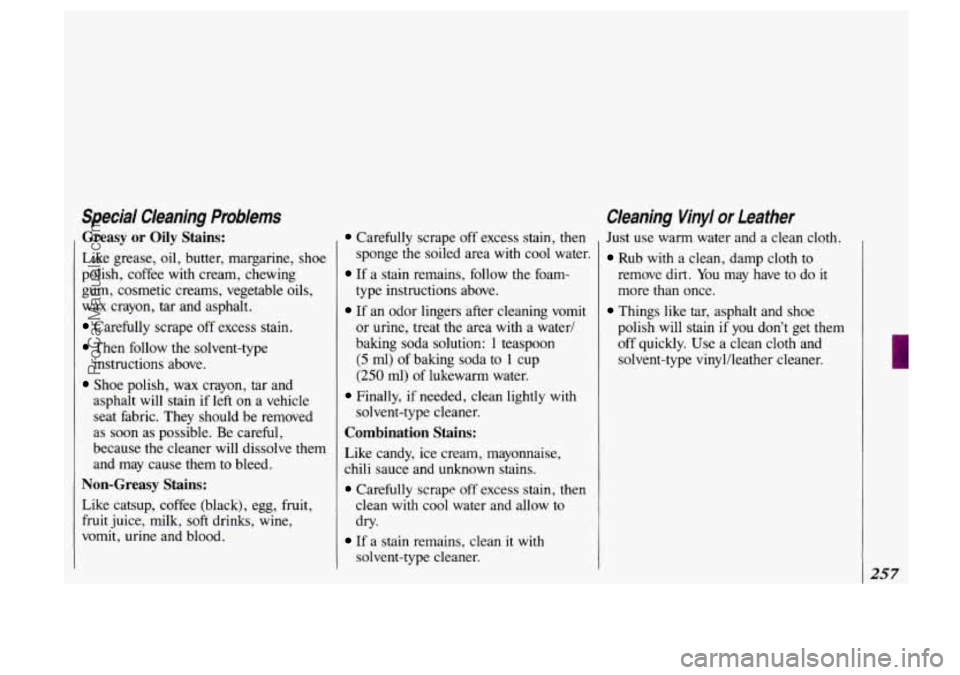
Special Cleaning Problems
Greasy or Oily Stains:
Like grease, oil, butter, margarine, shoe
polish, coffee with cream, chewing
gum, cosmetic creams, vegetable oils,
wax crayon, tar and asphalt.
Carefully scrape off excess stain.
Then follow the solvent-type
Shoe polish, wax crayon, tar and
instructions
above.
asphalt will stain if left on a vehicle
seat fabric. They should be removed
as soon as possible. Be careful,
because
the cleaner will dissolve them
and may cause them to bleed.
Non-Greasy Stains:
Like catsup, coffee (black), egg, fruit,
fruit juice, milk, soft drinks, wine,
vomit, urine and blood.
Carefully scrape off excess stain, then
sponge
the soiled area with cool water.
If a stain remains, follow the foam-
type instructions above.
If an odor lingers after cleaning vomit
or urine, treat
the area with a water/
baking soda solution:
1 teaspoon
(5 ml) of baking soda to 1 cup
(250
ml) of lukewarm water.
Finally, if needed, clean lightly with
solvent-type cleaner.
Combination Stains:
Like candy, ice cream, mayonnaise,
chili sauce and unknown stains.
Carefully scrape off excess stain, then
clean with cool water and allow to
dry.
If a stain remains, clean it with
solvent-type cleaner.
Cleaning Vinyl or Leafher
Just use warm water and a clean cloth.
Rub with a clean, damp cloth to
remove dirt. You may have to do
it
more than once.
polish will stain
if you don’t get them
off quickly. Use a clean cloth and
solvent-type vinyl/leather cleaner.
Things like tar, asphalt and shoe
257
ProCarManuals.com
Page 260 of 323
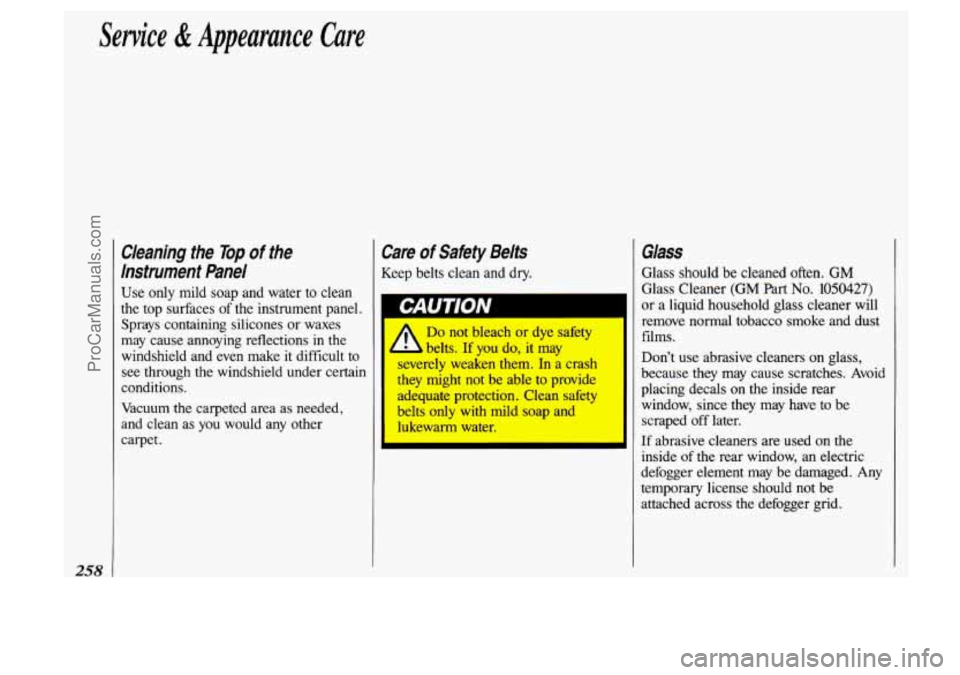
Service & Appearance Care
258
Cleaning the Top of the
Instrument Panel
Use only mild soap and water to clean
the top surfaces of the instrument panel.
Sprays containing silicones or waxes
may cause annoying reflections in the
windshield and even make it difficult to
see through the windshield under certain
conditions.
Vacuum the carpeted area as needed,
and clean as you would any other
carpet.
Care of Safety Belts
Keep belts clean and dry.
A Do not bleach or dye safety
severely weaken them. In a crash
they might not be able to provide I
adequate protection. Clean safety
belts
only with mild soap and
lukewarm water.
- L belts. If you do, it may
Glass
Glass should be cleaned often. GM
Glass Cleaner (GM Part No. 1050427)
or a liquid household glass cleaner will
remove normal tobacco smoke and dust
films.
Don’t use abrasive cleaners on glass,
because they may cause scratches. Avoid
placing decals on the inside rear
window, since they may have
to be
scraped off later.
If abrasive cleaners are used on the
inside of the rear window, an electric
defogger element may be damaged. Any
temporary license should not be attached across the defogger grid.
ProCarManuals.com